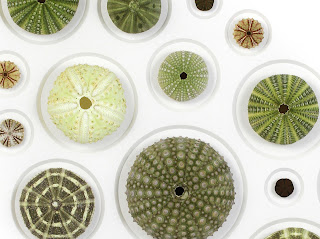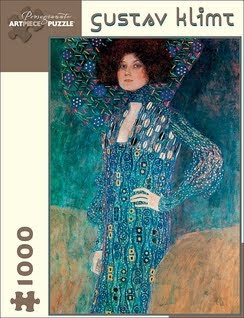Friday, May 4, 2012
Insect Art by Christopher Marley
 |
| Christopher Marley |
Christopher Marley, one of the most distinctive artists Pomegranate publishes, has traveled all across the globe collecting thousands of interesting, colorful, and bizarrely shaped specimens to create his signature mosaic art. These mosaics might include plants, crystal formations, fossils, uncut gemstones, or seashells, but if you ask me, Chris’s most exotic arrangements come from his collection of insects—or should I say BUGS–you know, the creepy crawly kind that make most of us squirm a little or even jump!
I
have to admit, I’m the jumpy type. If I’m sitting at my desk at work
and someone mentions a spider in the room, my feet instantly come off
the floor.
I can imagine why Miss Muffet
was frightened away, especially if the great spider who sat down beside
her looked anything like the one Chris has in his collection below! And you can see, it would most definitely make just about anyone JUMP—probably right on TOP of their desk.
These amazing insects have long scientific names that I can’t pronounce, but, of course, Chris can say them easily without hesitation. The names are usually made up of two Latin words: the first word is always capitalized; it’s the genus name, which somewhat describes the insect—either its taxonomic classification, who discovered it, or what creepy thing it can do. The second word, which starts with a lowercase letter, is its species name. For example, the Latin name for the household cat is “Felis catus.”
| "Little Miss Muffet" illustration by Wallace Denslow |
 |
| Cave spider (Amblypygi, Tailless whip scorpion, from Latin America) |
These amazing insects have long scientific names that I can’t pronounce, but, of course, Chris can say them easily without hesitation. The names are usually made up of two Latin words: the first word is always capitalized; it’s the genus name, which somewhat describes the insect—either its taxonomic classification, who discovered it, or what creepy thing it can do. The second word, which starts with a lowercase letter, is its species name. For example, the Latin name for the household cat is “Felis catus.”
I’ve
read a little about Chris Marley’s childhood, including his reaction to
insects when he was young—which apparently was very similar to my
own—and his early career choices. Born in Southern California, Chris
spent most of his teenage years in Oregon and then pursued a modeling
career; photos of Chris wearing clothes by renowned designers were
featured in many well-known fashion magazines for more than a decade. So
I’ve been wondering: Where did his fascination with insects come from?
And how did he amass such a collection of these creepy, crawling
critters?
I
was grateful for the opportunity to ask Chris a few questions about
himself and about his passion for collecting insects. Anyone who is
lucky enough to view his artwork up close can see that it is perfectly
designed and cleverly arranged into colorful mandalas, spectacular mosaics, or kaleidoscopes—all
made of BUGS. Some of which are absolutely amazing and beautiful, and
others, well, kind of scary-looking. The surreal beauty and true vibrant
colors of Chris’s art are likely to make anyone share in my curiosity
and attraction—
 |
| Beetle Prism |
Christopher, when did your fascination with bugs begin?
My fascination with insects began at an early age, though it was chiefly a fascination with how to avoid them. Though enthralled by the world of fantasy and the freakish—as a young and not so young artist, my subject matter of choice was consistently the fantastical and macabre—I did not make the connection between things I legitimately feared and the creatures I dreamed up until much later in my life. Insects were one of only three fears I prided myself on.
Did the concept to create art pieces using a variety of different species come soon after?It was a bit of a process over a few years of going from phobia of insects to collector of insects to student of all things entomological. From there, going full circle and bringing insects into my repertoire as a design medium was almost inevitable.



The iridescent eye-catching colors (like these Jewel beetles above) are very vibrant; it’s hard to believe they are truly real. Do you alter your specimens in any way?
Nope. The only exception is the one that people would suspect the least. The Leaf mimics
fade notoriously quickly, so we do dye those back to their original
color to minimize fading, but that is the extent of my color
manipulation.
My fascination with insects began at an early age, though it was chiefly a fascination with how to avoid them. Though enthralled by the world of fantasy and the freakish—as a young and not so young artist, my subject matter of choice was consistently the fantastical and macabre—I did not make the connection between things I legitimately feared and the creatures I dreamed up until much later in my life. Insects were one of only three fears I prided myself on.
Did the concept to create art pieces using a variety of different species come soon after?It was a bit of a process over a few years of going from phobia of insects to collector of insects to student of all things entomological. From there, going full circle and bringing insects into my repertoire as a design medium was almost inevitable.



The iridescent eye-catching colors (like these Jewel beetles above) are very vibrant; it’s hard to believe they are truly real. Do you alter your specimens in any way?
 |
| Leaf-mimic mantis |
Can you briefly tell me the important steps in designing each composition?
First, the species must be located and a supply of them obtained. Believe it or not, I am only now beginning to discipline myself to only design with specimens I actually have. My imagination has often outstripped my reality in the past. I then work on preparing the insects in a variety of ways until I settle on one that I feel maximizes the aesthetic strengths of the particular species while rendering it most usable for larger composition. Compositions for me can be organic and instinctual or laborious and painstaking—I'm never really sure which path a particular composition will take until it is completed. Hands-on is always best, however. I don't have much luck with computer mockups. Lastly, the piece must be fumigated and hermetically sealed to last a lifetime.
First, the species must be located and a supply of them obtained. Believe it or not, I am only now beginning to discipline myself to only design with specimens I actually have. My imagination has often outstripped my reality in the past. I then work on preparing the insects in a variety of ways until I settle on one that I feel maximizes the aesthetic strengths of the particular species while rendering it most usable for larger composition. Compositions for me can be organic and instinctual or laborious and painstaking—I'm never really sure which path a particular composition will take until it is completed. Hands-on is always best, however. I don't have much luck with computer mockups. Lastly, the piece must be fumigated and hermetically sealed to last a lifetime.
 |
| Urchin Spheres |

You must have traveled to some very exotic places to find these distinctive objects. Where has your passion taken you?
I've spent years in several countries in Latin America—chiefly Chile, Peru, and Costa Rica—but many of the neighboring countries as well. I've also spent years in Southeast Asia—mainly western Malaysia and Borneo, Indonesia, Thailand, China, and Taiwan—again with periodic visits to most nearby countries. Africa is a distant third continent, with work in Sub-Saharan Africa as well as South Africa. Many people are surprised to learn that we get a good number of species from southern Europe, so I've spent some time in France, Spain, Germany, Austria, Switzerland, and about one-half year in Greece. I've never been to Australia.
| Amazon River Rainforest in Peru |
Unfortunately, it is not a question without controversy. The most dangerous insects in the world are the disease vectors, but as that is not very sexy (and I'm sure not what you are after), I would have to say that as far as physical prowess and imposing size, it is tough to beat some of the largest longhorn beetles like Macrodontia cervicornis, which reach sizes in excess of 17 cm, and Titanus giganteus, which is reportedly capable of removing a finger if you are unlucky enough to let it get its mandibles around one. Some of the giant tarantula hawks (Pepsis wasps) have terribly painful bites and stings, as do the giant bullet ants of the Amazon, which can be over an inch long. Personally, though not an insect, some of the centipedes are most frightening to me; one species reaches over a foot in length and hunts snakes, birds, lizards, frogs, etc.—very poisonous. Of course, in sheer length, nothing comes close to the Pharnacia walking sticks, which can reach nearly 2 feet. [Eeek!]
 |
| Macrodontia cervicorni |
 |
| Titanus giganteus |
The only way to deplete an insect population is to reduce or eliminate the species’ ability to breed. Insects are [at] the bottom of the food chain and depend on their ability to reproduce themselves prolifically to ensure the maintenance of their populations. Inasmuch as we can give local [people] living in the areas of threatened ecosystems an alternative to developing the land for ranching, agriculture, or logging, we [can] help to reverse the economic pressure to develop the land, which does destroy the insects’ ability to reproduce. By creating a worldwide network of insect collectors, the habitat of those insects becomes valuable in it's original pristine state, helping to ensure that the insect populations—of which we take a minute fraction of a percentage—are able to remain intact.
One last question I have to ask: What thoughts do you want people to walk away with after viewing your form of art?
An awe of the natural world and an increased appreciation for the artistry of its design.
 Well there you have it.
Well there you have it.Chris, I’m thankful for your informative answers to my questions. I hope our readers will understand how talented you really are. I’m grateful that you have shared the unknown with all of us through your artwork. The next time I see something crawling underfoot, maybe I’ll stop and stare a little while longer and admire the beauty that most of us fail to see–of course, right after I jump up on the nearest chair or desk!
Ha ha, I’ll leave you all with this cute little Weevil image and an awesome video interview with Chris that was featured on Seattle's King 5 Evening Magazine!
Monica Becker
Originally posted on Pomegranate’s US blog
http://pomegranatecom.blogspot.com/































